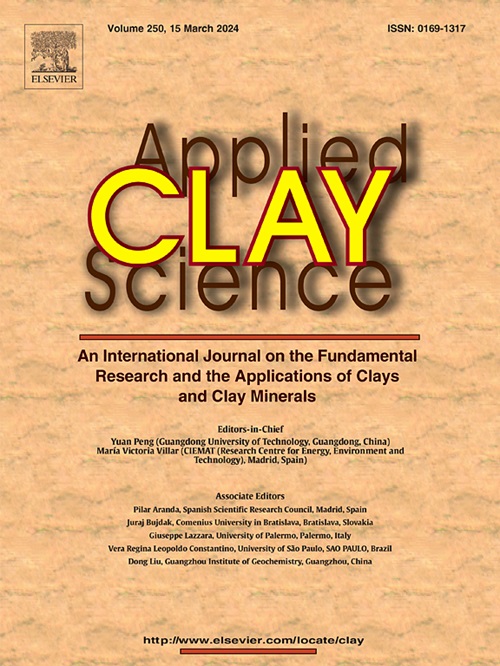在替代缓冲材料实验中,在膨润土-水相互作用的热梯度上跟踪蒙脱石中的结构H-和o -同位素交换
IF 5.3
2区 地球科学
Q2 CHEMISTRY, PHYSICAL
引用次数: 0
摘要
为了跟踪蒙脱石和水在热梯度上的结构稳定的氢(H)-和氧(O)-同位素交换,在瑞典Äspö硬岩实验室对五种不同的膨润土材料进行了替代缓冲材料(ABM) 2和5实验,研究了样品。ABM实验旨在研究不同膨润土材料作为长期地下储存库中存放乏核燃料罐周围缓冲液的稳定性。ABM2和ab5实验包括将压实的膨润土圆盘垂直堆叠在宿主岩石井眼的中央加热系统周围数年,这种配置旨在模拟放射性核素衰变期间发生的加热。ABM实验提供了一个独特的机会,在一个长期的、不完善的、自然的、但仍然是半受控的环境中跟踪蒙脱石和水之间的同位素交换。ABM2和ABM5包体的h同位素组成存在明显差异。o同位素组成在两个ABM包体之间表现出相似的变化趋势。在两个ABM包中,H-和o -同位素交换在较高温度下进行得更深入,但H-和o -同位素交换的机制不同。在没有蒙脱石蚀变的情况下,在温度为130 ~ 150℃时,h同位素组成几乎达到模型平衡值,这表明质子交换是交换机制。氧的交换率计算表明,氧远未达到平衡,比氢更耐交换。涉及细蒙脱石的溶解/再沉淀机制最简单地解释了氧交换的计算百分比,其范围在初始和模拟平衡o同位素组成之间。本文章由计算机程序翻译,如有差异,请以英文原文为准。
Tracking structural H- and O-isotope exchange in smectite during bentonite-water interactions over a thermal gradient in the Alternative Buffer Materials experiments
In order to track structural stable hydrogen (H)- and oxygen (O)-isotope exchange between smectite and water over a thermal gradient, samples were studied from the Alternative Buffer Materials (ABM) 2 and 5 experiments conducted at the Äspö Hard Rock Laboratory in Sweden for five different bentonite materials. The ABM experiments were designed to investigate the stability of different bentonite materials of interest as buffers around canisters containing spent nuclear fuel in long-term underground repositories. The ABM2 and 5 experiments consisted of compacted bentonite discs stacked vertically around a central heating system in a host-rock borehole for several years, with this configuration intended to simulate heating that occurs during radionuclide decay. The ABM experiments provided a unique opportunity to track isotopic exchange between smectite and water in a long-term, imperfect, natural but still semi-controlled environment. Clear differences were observed for H-isotope compositions between the ABM2 and ABM5 packages. O-isotope compositions showed similar trends between the two ABM packages. In both ABM packages H- and O-isotope exchange was more progressed at higher temperatures but the mechanisms for H- and O-isotope exchange proceeded differently. H-isotope compositions nearly reached modeled equilibrium values at temperatures between 130 and 150 °C in the absence of any smectite alteration, which suggests proton exchange as the exchange mechanism. The percentage of exchange calculated for oxygen showed that it was far from reaching equilibrium and was more resistant to exchange than hydrogen. A dissolution/re-precipitation mechanism involving fine smectite most simply explains calculated percentages of oxygen exchanged that range between initial and modeled equilibrium O-isotope compositions.
求助全文
通过发布文献求助,成功后即可免费获取论文全文。
去求助
来源期刊

Applied Clay Science
地学-矿物学
CiteScore
10.30
自引率
10.70%
发文量
289
审稿时长
39 days
期刊介绍:
Applied Clay Science aims to be an international journal attracting high quality scientific papers on clays and clay minerals, including research papers, reviews, and technical notes. The journal covers typical subjects of Fundamental and Applied Clay Science such as:
• Synthesis and purification
• Structural, crystallographic and mineralogical properties of clays and clay minerals
• Thermal properties of clays and clay minerals
• Physico-chemical properties including i) surface and interface properties; ii) thermodynamic properties; iii) mechanical properties
• Interaction with water, with polar and apolar molecules
• Colloidal properties and rheology
• Adsorption, Intercalation, Ionic exchange
• Genesis and deposits of clay minerals
• Geology and geochemistry of clays
• Modification of clays and clay minerals properties by thermal and physical treatments
• Modification by chemical treatments with organic and inorganic molecules(organoclays, pillared clays)
• Modification by biological microorganisms. etc...
 求助内容:
求助内容: 应助结果提醒方式:
应助结果提醒方式:


